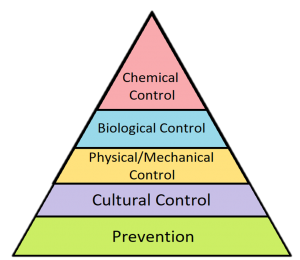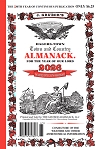INTEGRATED PEST MANAGEMENT
BUILDING A TOOLKIT TO TACKLE FARM AND GARDEN PESTS
What is Integrated Pest Management?
Integrated pest management, commonly abbreviated to IPM, is the use of multiple tactics in combination to achieve effective management of pests. By focusing on diverse strategies to control weeds, insect pests, and diseases, we can control pests over the long-term in a manner that reduces harm to human health and wildlife, beneficial and non-target organisms and the environment. Using IPM often means that we must plan ahead to prevent pests from reaching problematic levels in our gardens, crops or home. We focus on learning the conditions that allow pests to thrive and reduce those environments as much as we can. The tactics we integrate to build an integrated pest management approach are often represented through a pyramid where we focus on building a foundation through prevention and cultural tactics at the bottom of the pyramid and work our way up to tactics at the top, which should be used as a last resort when necessary.

Image credit: University of Florida Extension
Prevention
Prevention should always be our first tactic we use in managing pests in our farms or gardens. By preventing pests from ever becoming an issue in the first place, we save ourselves money, time, and energy in managing pests later. For homeowners, this could mean avoiding planting invasive species or species known to become weedy. For farmers, this could mean being careful not to spread weed seeds on planting or harvesting equipment.
Cultural Control
Cultural control focuses on altering the environment around our crops or garden such that pests are no longer able to thrive and impact our plants. This could mean choosing a variety of plant that isn’t as susceptible to a pest or disease we commonly encounter. Another example would be to increase space between plants or prune back unnecessary vegetation to allow airflow to reduce humidity within the plant canopy, as high humidity can favor the spread of many diseases.
Biological Control
Although biological control can take some time and effort to implement, it can have long-lasting benefits. Using biological control means using living organisms to manage pests in the farm and garden, such as predators, parasites, or pathogens that infect pests. In the garden, planting flowering plants and leaving residue available on the soil surface through a straw mulch can provide food resources and habitat available for naturally occurring predators and parasites and allow their populations to build up. For farmers, reducing the amount of tillage used or planting a winter cover crop can help support predator populations. It is important to remember that many of the insecticides we use to manage insect pests will also kill insects that are predators, so using pesticides only when needed is important to ensure effectiveness of biological control.
Mechanical and Physical Controls
Mechanical and physical controls include traps, netting, or other physical barriers between the pest and its host or food source. Using netted row covers over fruit trees or berry bushes to prevent birds from feeding on fruit is one example. Another would be to use a straw mulch or rolled cover crop residue on the soil surface to prevent weeds from growing on the exposed soil. Traps can provide direct control of pests, such as through rodent traps or bait stations. They can also be used as a monitoring tool for other pests to allow us to detect activity of a pest in our fields or gardens and help us decide if we need additional strategies to control our pests.
Chemical Control
If the use of prevention, cultural controls, biological control, and physical controls have not been sufficient to keep pests from becoming a problem, then there are numerous chemical options for many of the pests we encounter. Assessing risk through the number of insects caught in a trap or by inspecting our plants for pest feeding or disease infection helps us determine whether we need to use a pesticide to reduce damage. Pesticides can range from broad-spectrum with toxicity to many types of pests and other organisms to more selective options that are only toxic to a small number of organisms. To use an IPM approach, choose the most selective pesticide that will be effective against the pest you are dealing with and make sure to apply it in a way that reduces risk to non-target organisms and the environment.
To summarize, it is important to identify the pest(s) we have so we can determine what management practices will be effective against them and how we can prevent their populations from growing. Once we have done our best through prevention, there are numerous strategies we can take to reduce the risk of damage from pests. If we are still seeing damage, it is important to measure the amount of damage we are seeing and understanding the life cycle and risk factors of our pest to know whether it is worth applying a product to manage it. Additionally, it is important to keep records for ourselves on what we have tried to manage pests in our garden or on our farm so we can use that information to prepare for the next season.
To summarize, it is important to identify the pest(s) we have so we can determine what management practices will be effective against them and how we can prevent their populations from growing. Once we have done our best through prevention, there are numerous strategies we can take to reduce the risk of damage from pests. If we are still seeing damage, it is important to measure the amount of damage we are seeing and understanding the life cycle and risk factors of our pest to know whether it is worth applying a product to manage it. Additionally, it is important to keep records for ourselves on what we have tried to manage pests in our garden or on our farm so we can use that information to prepare for the next season.
Karly Regan
Horticulture Educator
717-263-9226




















